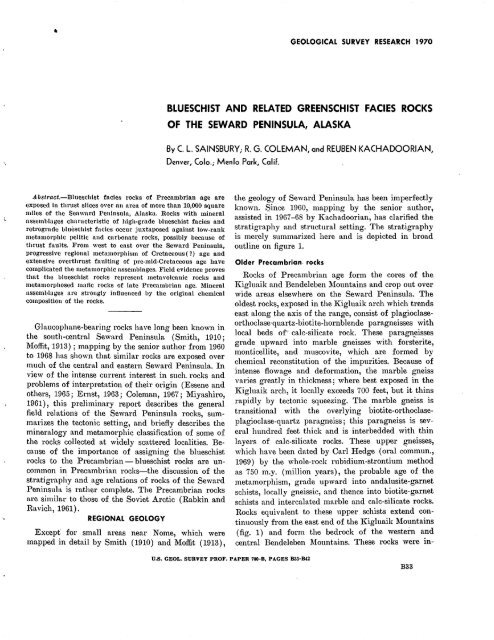RESEARCH· ·1970·
RESEARCH· ·1970·
RESEARCH· ·1970·
Create successful ePaper yourself
Turn your PDF publications into a flip-book with our unique Google optimized e-Paper software.
GE,OLOGICAL SURVEY RESEARCH 1970<br />
BLUESCHIST AND RELATED GREENSCHIST FACIES ROCKS<br />
OF THE SEWARD PENINSULA, ALASKA<br />
By C. L. SAINSBURY; R. G. COLEMAN, and REUBEN KACHADOORIAN,<br />
Denver, Colo.; Menlo Park, Calif.<br />
A.bstra.ct.-Blueschist facies rocks of Precambrian age are<br />
exposed in thrust slices over nn urea of more than 10,000 square<br />
miles of the Senwnrd Peninsuln, Alaslm. Rocl{S with mineral<br />
nssemblnges chnr·ucteristic of high-grade blueschist facies and<br />
retrogrudc IJlueschist fncies occur juxtnposed against low-rank<br />
metumorphic pelitic nnd curiJonate rocl{S, possibly because of<br />
thrust fnults. }"'rom west to enst over the Seward Peninsula,<br />
progressive reglonul metamorphism of Cretaceous ( ?) age and<br />
extensive overthrust faulting of pre-mid-Cretaceous age have<br />
complicnted the metnmorphic nssemblages. ]j"'ield evidence proves<br />
thnt the blueschist rocks represent meta volcanic rocks and<br />
metumorphosed mnflc rocl\:S of lute PrecamiJrian age. Mineral<br />
usser:nhluges are strongly influenced by the original chemical<br />
composition of the rocl\:S.<br />
G.la,ucophane-bearing rocks have long been known in<br />
the south-central Sewa,rd Peninsula (Smith, 1910;<br />
l\1offi.t, 191.3) ; mn.pping by the senior author from 1960<br />
to 1968 has shown that similar rocks are exposed over<br />
much of the central and eastern Seward Peninsula. In<br />
view of the intense current interest in such.. rocks and<br />
problems of interpretation of their origin (Essene and<br />
others, 1965; Ernst, 1963; Coleman, 1967; l\1iyashiro,<br />
1.961), this preliminary report describes the general<br />
field relations of the Seward Peninsula rocks, summarizes<br />
the tectonic setting, and briefly describes the<br />
minern.logy and metamorphic classification of some of<br />
the rocks collected at widely scattered localities. Because<br />
of the importance of assigning the blueschist<br />
rocks to the Precambrian- blueschist rocks are uncommon<br />
in Precambrian rocks-the discussion of the<br />
strn.tigr·apl~y and age relations of rocks of the Seward<br />
Peninsula is rather complete. The Precambrian rocks<br />
are similar to those of the Soviet Arctic (Rabkin and<br />
Ravich, 1961).<br />
REGIONAL GEOLOGY<br />
Except for small areas near Nome, which were<br />
mapped in detail by Smith ( 1910) and l\1offit ( 1913),<br />
the geology of Seward Peninsula has been imperfectly<br />
known. Since 1960, mapping by the senior author,<br />
assisted in 1967-68 by J(achadoorian~ has clarified the<br />
stratigraphy and structural setting. The stratigraphy<br />
is mm:ely summa.rized here and is depicted in broad<br />
outline on figure 1..<br />
Older Pre~cambrian. rocks<br />
Rocks of Precambrian age form the cores of the<br />
IGgluaik and Bendeleben l\1ountains and crop out over<br />
wide areas elsewhere on the Seward Peninsula. The<br />
oldest rocks, exposed in the IGgluaik arch which trends<br />
east along the axis of the range, consist of plagioclaseorthoclase-quartz-biotite-hornblende<br />
paragneisses with<br />
local beds of·· calc-silicate rock. These paragn.~isses<br />
grade upward into marble gneisses with forsterite,<br />
monticellite, and muscovite, which are form,ed by<br />
chemical reconstitution of the impurities. Because of<br />
intense flowage and deformation, the 1narble gneiss<br />
varies greatly in thickness; where best exposed in the<br />
IGgluaik arch, it locally exceeds 700 feet, but it thins<br />
rapidly by tectonic squeezing. The marble gneiss is<br />
transitional with the overlying biotite-orthoclaseplagioclase-quartz<br />
paragneiss; this paragneiss is several<br />
hundred feet thick and is interbedded with thin<br />
layers of calc-silicate rocks. These upper gneisses,<br />
which have been dated by Carl Hedge (oral commun.,<br />
1.969) by the whole-rock rubidium-strontium method<br />
as 750 m.y. (million years), the probable age of the<br />
metamorphism, grade upward into andalusite-garnet<br />
schists, locally gneissic, and thence into biotite-garnet<br />
schists and intercalated marble and calc-silicate rocks.<br />
Rocks equivalent to these upper schists extend continuously<br />
from the east end of the IGgluaik l\1ountains<br />
(fig. 1) and form the bedrock of the western and<br />
central Bendeleben l\1ountains. These rocks were in-<br />
U.S. GEOL. SURVEY PROF. PAPER 700-B, PAGES B33-B42<br />
B33
















